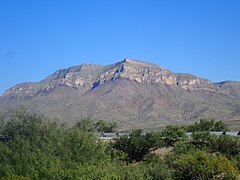| Red House Formation | |
|---|---|
| Stratigraphic range: Bashkirian–Moscovian PreꞒ Ꞓ O S D C P T J K Pg N | |
 Red House Formation is the darker band forming a slight slope immediately below the limestone ledges capping Timber Mountain, New Mexico, USA. Red House Formation is the darker band forming a slight slope immediately below the limestone ledges capping Timber Mountain, New Mexico, USA. | |
| Type | Formation |
| Underlies | Nakaye Formation |
| Overlies | Lake Valley Limestone, Percha Shale |
| Thickness | 500 ft (150 m) |
| Lithology | |
| Primary | Limestone |
| Other | Shale, claystone |
| Location | |
| Coordinates | 33°01′06″N 107°14′20″W / 33.018265°N 107.238855°W / 33.018265; -107.238855 |
| Region | New Mexico |
| Country | United States |
| Type section | |
| Named for | Red House Mountain |
| Named by | V.C. Kelley and Caswell Silver |
| Year defined | 1952 |
  | |
The Red House Formation is a geologic formation found in the Caballo Mountains in New Mexico. It preserves fossils dating back to the middle to late Pennsylvanian.
Description
The formation consists mostly of thinly bedded dark gray limestone and shale or claystone containing limestone nodules and lenses. Some massive cherty limestone beds are locally present. It rests unconformably on the Lake Valley Limestone or Percha Shale, with a thin sandstone bed at its base. Thickness is about 500 feet (150 m). It is overlain by the Nakaye Formation.
Fossils
Many of the beds are abundantly fossiliferous. The formation dates from the late Morrowan (Bashkirian) to the early Atokan (Moscovian).
History of investigation
The formation was first described by V.C. Kelley and Caswell Silver in 1952 and assigned to the now-obsolete Magdalena Group. G.O. Bachman and D.A. Myers criticized its definition in 1975, but it is accepted by Barry Kues and Katherine Giles. In 2016, Lucas and coinvestigators recommended that the local names Green Canyon Group, Arrey Formation, Apodaca Formation, Mud Springs Group, Fra Cristobal Formation, and Chuchillo Negro Formation be abandoned in favor of the Red House Formation.
See also
References
- ^ Kelley, V.C.; Silver, Caswell (1952). "Geology of the Caballo Mountains; with special reference to regional stratigraphy and structure and to mineral resources, including oil and gas". University of New Mexico Publications in Geology. 4.
- ^ Bachman, G.O.; Myers, D.A. (1975). "The Lead Camp Limestone and its correlatives in south-central New Mexico" (PDF). New Mexico Geological Society Field Conference Guidebook. 26: 105–108. Retrieved 30 July 2020.
- ^ Kues, B.S.; Giles, K.A. (2004). "The late Paleozoic Ancestral Rocky Mountain system in New Mexico". In Mack, G.H.; Giles, K.A. (eds.). The geology of New Mexico. A geologic history (Special Volume 11). New Mexico Geological Society. pp. 95–136.
- Lucas, S.G.; Krainer, Karl; Barrick, J.E.; Vaaq, M.K. (2016). "The Pennsylvanian System in the Mud Springs Mountains, Sierra County, New Mexico, USA". New Mexico Museum of Natural History and Science Bulletin. 69. Retrieved 29 July 2020.